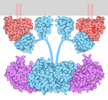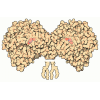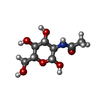+ Open data
Open data
- Basic information
Basic information
| Entry | Database: PDB / ID: 7v3p | ||||||
|---|---|---|---|---|---|---|---|
| Title | Cryo-EM structure of the IGF1R/insulin complex | ||||||
 Components Components |
| ||||||
 Keywords Keywords | MEMBRANE PROTEIN / The type 1 insulin-like growth factor receptor (IGF1R) | ||||||
| Function / homology |  Function and homology information Function and homology informationprotein kinase complex / insulin-like growth factor receptor activity / insulin-like growth factor binding / Signaling by Type 1 Insulin-like Growth Factor 1 Receptor (IGF1R) / protein transporter activity / IRS-related events triggered by IGF1R / transcytosis / insulin receptor complex / insulin-like growth factor I binding / positive regulation of protein-containing complex disassembly ...protein kinase complex / insulin-like growth factor receptor activity / insulin-like growth factor binding / Signaling by Type 1 Insulin-like Growth Factor 1 Receptor (IGF1R) / protein transporter activity / IRS-related events triggered by IGF1R / transcytosis / insulin receptor complex / insulin-like growth factor I binding / positive regulation of protein-containing complex disassembly / insulin receptor activity / alphav-beta3 integrin-IGF-1-IGF1R complex / regulation of JNK cascade / dendritic spine maintenance / peptidyl-tyrosine autophosphorylation / insulin binding / negative regulation of glycogen catabolic process / positive regulation of nitric oxide mediated signal transduction / negative regulation of fatty acid metabolic process / negative regulation of feeding behavior / Signaling by Insulin receptor / IRS activation / regulation of protein secretion / Insulin processing / positive regulation of peptide hormone secretion / positive regulation of respiratory burst / amyloid-beta clearance / negative regulation of acute inflammatory response / Regulation of gene expression in beta cells / alpha-beta T cell activation / Respiratory syncytial virus (RSV) attachment and entry / insulin receptor substrate binding / positive regulation of dendritic spine maintenance / Synthesis, secretion, and deacylation of Ghrelin / negative regulation of respiratory burst involved in inflammatory response / activation of protein kinase B activity / negative regulation of protein secretion / negative regulation of gluconeogenesis / positive regulation of insulin receptor signaling pathway / positive regulation of glycogen biosynthetic process / fatty acid homeostasis / Signal attenuation / FOXO-mediated transcription of oxidative stress, metabolic and neuronal genes / SHC-related events triggered by IGF1R / negative regulation of lipid catabolic process / positive regulation of lipid biosynthetic process / negative regulation of oxidative stress-induced intrinsic apoptotic signaling pathway / regulation of protein localization to plasma membrane / phosphatidylinositol 3-kinase binding / nitric oxide-cGMP-mediated signaling / transport vesicle / COPI-mediated anterograde transport / positive regulation of nitric-oxide synthase activity / negative regulation of MAPK cascade / Insulin receptor recycling / negative regulation of reactive oxygen species biosynthetic process / insulin-like growth factor receptor binding / positive regulation of brown fat cell differentiation / NPAS4 regulates expression of target genes / neuron projection maintenance / endoplasmic reticulum-Golgi intermediate compartment membrane / positive regulation of mitotic nuclear division / Insulin receptor signalling cascade / insulin-like growth factor receptor signaling pathway / positive regulation of glycolytic process / positive regulation of cytokine production / endosome lumen / positive regulation of long-term synaptic potentiation / acute-phase response / positive regulation of protein secretion / positive regulation of D-glucose import / insulin receptor binding / positive regulation of cell differentiation / Regulation of insulin secretion / cellular response to glucose stimulus / phosphatidylinositol 3-kinase/protein kinase B signal transduction / wound healing / positive regulation of neuron projection development / receptor protein-tyrosine kinase / hormone activity / negative regulation of protein catabolic process / regulation of synaptic plasticity / positive regulation of protein localization to nucleus / Golgi lumen / vasodilation / cognition / glucose metabolic process / cellular response to amyloid-beta / insulin receptor signaling pathway / cell-cell signaling / glucose homeostasis / regulation of protein localization / positive regulation of cold-induced thermogenesis / protein autophosphorylation / PI5P, PP2A and IER3 Regulate PI3K/AKT Signaling / positive regulation of cell growth / protease binding / protein tyrosine kinase activity / secretory granule lumen / Extra-nuclear estrogen signaling Similarity search - Function | ||||||
| Biological species |  Homo sapiens (human) Homo sapiens (human) | ||||||
| Method | ELECTRON MICROSCOPY / single particle reconstruction / cryo EM / Resolution: 3.6 Å | ||||||
 Authors Authors | Zhang, J. / Liu, C. / Zhang, X. / Wei, T. / Wu, C. | ||||||
| Funding support |  China, 1items China, 1items
| ||||||
 Citation Citation |  Journal: To Be Published Journal: To Be PublishedTitle: Cryo-EM structure of the IGF1R/insulin complex Authors: Liu, C. / Zhang, J. / Zhang, X. / Wei, T. / Wu, C. | ||||||
| History |
|
- Structure visualization
Structure visualization
| Structure viewer | Molecule:  Molmil Molmil Jmol/JSmol Jmol/JSmol |
|---|
- Downloads & links
Downloads & links
- Download
Download
| PDBx/mmCIF format |  7v3p.cif.gz 7v3p.cif.gz | 558.5 KB | Display |  PDBx/mmCIF format PDBx/mmCIF format |
|---|---|---|---|---|
| PDB format |  pdb7v3p.ent.gz pdb7v3p.ent.gz | 461.2 KB | Display |  PDB format PDB format |
| PDBx/mmJSON format |  7v3p.json.gz 7v3p.json.gz | Tree view |  PDBx/mmJSON format PDBx/mmJSON format | |
| Others |  Other downloads Other downloads |
-Validation report
| Summary document |  7v3p_validation.pdf.gz 7v3p_validation.pdf.gz | 709.7 KB | Display |  wwPDB validaton report wwPDB validaton report |
|---|---|---|---|---|
| Full document |  7v3p_full_validation.pdf.gz 7v3p_full_validation.pdf.gz | 737.8 KB | Display | |
| Data in XML |  7v3p_validation.xml.gz 7v3p_validation.xml.gz | 56.4 KB | Display | |
| Data in CIF |  7v3p_validation.cif.gz 7v3p_validation.cif.gz | 85.1 KB | Display | |
| Arichive directory |  https://data.pdbj.org/pub/pdb/validation_reports/v3/7v3p https://data.pdbj.org/pub/pdb/validation_reports/v3/7v3p ftp://data.pdbj.org/pub/pdb/validation_reports/v3/7v3p ftp://data.pdbj.org/pub/pdb/validation_reports/v3/7v3p | HTTPS FTP |
-Related structure data
| Related structure data | M: map data used to model this data |
|---|---|
| Similar structure data | Similarity search - Function & homology  F&H Search F&H Search |
- Links
Links
- Assembly
Assembly
| Deposited unit | 
|
|---|---|
| 1 |
|
- Components
Components
| #1: Protein | Mass: 105824.719 Da / Num. of mol.: 2 Source method: isolated from a genetically manipulated source Source: (gene. exp.)  Homo sapiens (human) / Gene: IGF1R / Production host: Homo sapiens (human) / Gene: IGF1R / Production host:  Homo sapiens (human) Homo sapiens (human)References: UniProt: P08069, receptor protein-tyrosine kinase #2: Protein/peptide | | Mass: 2383.698 Da / Num. of mol.: 1 Source method: isolated from a genetically manipulated source Source: (gene. exp.)  Homo sapiens (human) / Gene: INS / Production host: Homo sapiens (human) / Gene: INS / Production host:  Homo sapiens (human) / References: UniProt: P01308 Homo sapiens (human) / References: UniProt: P01308#3: Protein/peptide | | Mass: 3433.953 Da / Num. of mol.: 1 Source method: isolated from a genetically manipulated source Source: (gene. exp.)  Homo sapiens (human) / Gene: INS / Production host: Homo sapiens (human) / Gene: INS / Production host:  Homo sapiens (human) / References: UniProt: P01308 Homo sapiens (human) / References: UniProt: P01308#4: Sugar | ChemComp-NAG / Has ligand of interest | N | Has protein modification | Y | |
|---|
-Experimental details
-Experiment
| Experiment | Method: ELECTRON MICROSCOPY |
|---|---|
| EM experiment | Aggregation state: PARTICLE / 3D reconstruction method: single particle reconstruction |
- Sample preparation
Sample preparation
| Component | Name: Complex of the dimer IGF1R with insulin / Type: COMPLEX / Entity ID: #1-#3 / Source: RECOMBINANT |
|---|---|
| Source (natural) | Organism:  Homo sapiens (human) Homo sapiens (human) |
| Source (recombinant) | Organism:  Homo sapiens (human) Homo sapiens (human) |
| Buffer solution | pH: 7.4 |
| Specimen | Conc.: 1.5 mg/ml / Embedding applied: NO / Shadowing applied: NO / Staining applied: NO / Vitrification applied: YES |
| Vitrification | Cryogen name: ETHANE |
- Electron microscopy imaging
Electron microscopy imaging
| Experimental equipment |  Model: Titan Krios / Image courtesy: FEI Company |
|---|---|
| Microscopy | Model: TFS KRIOS |
| Electron gun | Electron source:  FIELD EMISSION GUN / Accelerating voltage: 300 kV / Illumination mode: FLOOD BEAM FIELD EMISSION GUN / Accelerating voltage: 300 kV / Illumination mode: FLOOD BEAM |
| Electron lens | Mode: BRIGHT FIELD |
| Image recording | Electron dose: 50 e/Å2 / Film or detector model: GATAN K2 SUMMIT (4k x 4k) |
- Processing
Processing
| CTF correction | Type: PHASE FLIPPING AND AMPLITUDE CORRECTION |
|---|---|
| 3D reconstruction | Resolution: 3.6 Å / Resolution method: FSC 0.143 CUT-OFF / Num. of particles: 356200 / Symmetry type: POINT |
 Movie
Movie Controller
Controller




 PDBj
PDBj





















